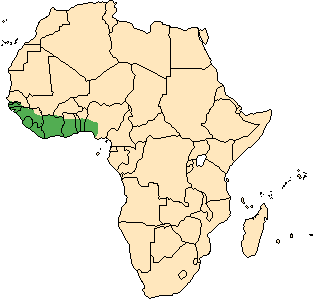![]() Return
to Artiodactyla
Return
to Artiodactyla
Classification
|
 Philantomba
maxwellii
Philantomba
maxwellii
Maxwell's duiker
![]()
Taxonomy
 |
 |
 |
Click on the pictures above for a larger view of the
photographs
|
||
General Characteristics
Body Length: 63-76 cm / 25-30 in.
Shoulder Height: 35-42 cm / 14-16.5 in.
Tail Length: 12-15 cm / 5-6 in.
Weight: 5-10 kg / 11-22 lb.The smooth coat is a slate grey or grey-brown colour, paling on the underside of the neck and belly. The facial markings are much darker and the head more angular than in the blue duiker. The forehead and nose bridge are dark brown or charcoal in colour, bordered by whitish grey stripes which run from above the eyes down to the nose. The maxillary gland, found on the cheek in front of the eye, is extremely large and conspicuous. The tail is thin and fringed with white hairs. The short, spike-like horns are found in both sexes, rising almost vertically from between the ears. Corrugated at the base, they grow about 5 cm / 2 inches long, but may be hidden by the dark brown forehead tuft.
Ontogeny and Reproduction
Gestation Period: 120 days.
Young per Birth: 1
Weaning: By 5 months.
Sexual Maturity: Females at 9-12 months, males at 12-18 months.
Life span: 10-12 years.Most births occur from January to March, with a second "round" occurring in August-September. Females generally produce one litter per year. Young are able to stand very soon after birth, and can walk within a few hours. They generally remain with their parents for their first year.
Ecology and Behavior
Like many small forest antelope, Maxwell's duiker is a nocturnal species whose wariness makes it difficult to observe. The general mode of locomotion is a jerky walk, generally accompanied by flicks of the tail. When startled, these antelope bound for cover. Pairs inhabit home ranges whose boundaries are actively marked by both sexes with secretions from the preorbital glands. These are believed to be defended territories, as neighbouring pairs do not usually overlap their ranges. Unknown animals are usually chased out of the home range by the owner of the same sex. Mutual marking between two individuals (generally a bonded pair) is common, and is accomplished by rubbing their heads together. Special sites are used as latrines, and several well-defined trails lead to these from frequently used sleeping areas.Family group: Bonded pairs.
Diet: Fruit, herbs, shrubs and new growth, probably some animal matter.
Main Predators: Leopard, golden cat, serval, Libyan wild cat, civets, large raptors, crocodile, monitors, pythons.
Distribution
Secondary forests and moist savanna in the southern portion of Africa west of the Niger river.

Range Map (Redrawn from IEA, 1998)
Conservation Status
Maxwell's duiker is considered to be a low risk, near threatened species by the IUCN (1996). The major source of endangerment is humans hunting them for the bushmeat trade.
Remarks
Closely related to the blue duiker, there is a current debate as to whether Maxwell's duiker is actually a separate species. Duiker ("DIKE-er") is Africaans for "diver", a reference to their quick flight into dense cover when alarmed.
- Local names (from Happold, 1973)
- Gadan Kurmi [Hausa]
- Otwe [Twi]
- Etu [Yoruba]
- Diafi, Forni [Dyula]
- French
- Céphalophe de Maxwell (Happold, 1973)
Literature Cited
Happold, D. C. D. 1973. Large Mammals of West Africa. London: Longman Group, Ltd.Happold, D. C. D. 1987. The Mammals of Nigeria. Oxford: Clarendon Press.
IEA (Institute of Applied Ecology). 1998. Cephalophus maxwelli. In African Mammals Databank - A Databank for the Conservation and Management of the African Mammals Vol 1 and 2. Bruxelles: European Commission Directorate. Available online at http://gorilla.bio.uniroma1.it/amd/amd337b.html
Kingdon J. 1997. The Kingdon field guide to African Mammals. Academic Press, London and New York: NaturalWorld..
Wilson, D. E., and D. M. Reeder [editors]. 1993. Mammal Species of the World (Second Edition). Washington: Smithsonian Institution Press. Available online at http://nmnhwww.si.edu/msw/
Return to Artiodactyla

![]()
© Brent Huffman, www.ultimateungulate.com |
|
|